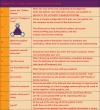Protecting healing relationships in the age of electronic health records: report from an international conference
- PMID: 31984362
- PMCID: PMC6952010
- DOI: 10.1093/jamiaopen/ooz012
Protecting healing relationships in the age of electronic health records: report from an international conference
Abstract
We present findings of an international conference of diverse participants exploring the influence of electronic health records (EHRs) on the patient-practitioner relationship. Attendees united around a belief in the primacy of this relationship and the importance of undistracted attention. They explored administrative, regulatory, and financial requirements that have guided United States (US) EHR design and challenged patient-care documentation, usability, user satisfaction, interconnectivity, and data sharing. The United States experience was contrasted with those of other nations, many of which have prioritized patient-care documentation rather than billing requirements and experienced high user satisfaction. Conference participants examined educational methods to teach diverse learners effective patient-centered EHR use, including alternative models of care delivery and documentation, and explored novel ways to involve patients as healthcare partners like health-data uploading, chart co-creation, shared practitioner notes, applications, and telehealth. Future best practices must preserve human relationships, while building an effective patient-practitioner (or team)-EHR triad.
Keywords: burnout; design; international experience with electronic health records; patient–practitioner relationship; patient–practitioner–computer triad; solutions to electronic health record challenges.
© The Author(s) 2019. Published by Oxford University Press on behalf of the American Medical Informatics Association.
Figures
References
-
- Frankel RF. When it comes to the physician-patient-computer relationship, the “eyes” have it In: Papadokos P, Bertman SE, eds. Distracted Doctoring: Returning to Patient-Centered Care in the Digital Age. New York, NY: Springer; 2017: 87–99.
-
- Wallace I. Is patient confidentiality compromised with the electronic health record?: A position paper. Comput Inform Nurs 2015; 332: 58–62. - PubMed
LinkOut - more resources
Full Text Sources

